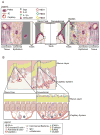The relationship of the oral microbiotia to periodontal health and disease
- PMID: 22018230
- PMCID: PMC3216488
- DOI: 10.1016/j.chom.2011.09.008
The relationship of the oral microbiotia to periodontal health and disease
Abstract
The oral microbial community represents the best-characterized consortium associated with the human host. There are strong correlations between the qualitative composition of the oral microbiota and clinically healthy or diseased states. However, additional studies are needed to elucidate the mechanisms that define these microbial/host relationships.
Copyright © 2011 Elsevier Inc. All rights reserved.
Figures

References
Publication types
MeSH terms
Grants and funding
LinkOut - more resources
Full Text Sources
Medical

